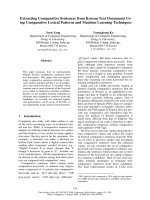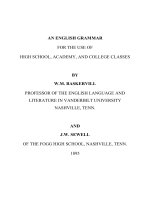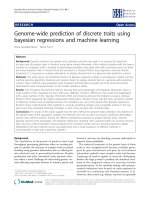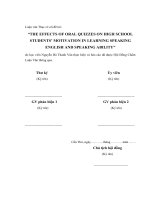High school dropout and machine learning
Bạn đang xem bản rút gọn của tài liệu. Xem và tải ngay bản đầy đủ của tài liệu tại đây (1.01 MB, 34 trang )
Stata
Conference
Dario Sansone
2017 User Conference
Baltimore
Now You See Me
High School Dropout and Machine Learning
Dario Sansone
Department of Economics
Georgetown University
Thursday July, 27th 2017
Introduction
• U.S. High School graduation rate of 82%, below OECD
average. Extensive literature (Murnane, 2013)
• Goal: use ML in Education
• Create an algorithm to predict which students are going to
drop out using only information available in 9th grade
• Current practices based on few indicators lead to poor
predictions
• Improvements using Big Data and ML
• Microeconomic foundations of performance evaluations
• Unsupervised ML to capture heterogeneity among weak
students
Machine Learning
• Econometrics: causal inference
• ML: prediction
• Takes into account the trade-off between bias and variance in
the MSE in order to maximize out-of-sample prediction.
• Algorithms can identify patterns too subtle to be detected by
human observations (Luca et al, 2016)
• ML applications limited in economics, but several policyrelevant issues that require accurate predictions (Kleinberg et
al., 2015)
• Ml is gaining momentum
Belloni et al (2014), Mullainathan and Spiess (2017)
• Reduce dropout rates in college
Aulck et al (2016), Ekowo and Palmer (2016)
Machine Learning - References
Comprehensive review:
• J. Friedman, T. Hastie, and R. Tibshirani, The Elements of
Statistical Learning, Springer.
MOOCs (w/o Stata):
• A. Ng, Machine learning, Coursera and Stanford University.
• J. Leek, R.D. Peng, B. Caffo, Practical Machine Learning,
Coursera and Johns Hopkins University
• T. Hastie and R. Tibshirani, An Introduction to Statistical
Learning
• S. Athey and G. Imbens, NBER 2015 Summer Institute
Podcast for economist/policy:
• APPAM – The Wonk
• EconTalk
Machine Learning - References
Intro for Economists:
• H.R. Varian, Big data: New tricks for econometrics, Journal of
Economic Perspectives, 28(2):3–27, 2014
• S. Mullainathan and J. Spiess. Machine learning: An applied
econometric approach. Journal of Economic Perspectives,
31(2):87–106, 2017
ML and Causal Inference:
• A. Belloni, V. Chernozhukov, and C. Hansen, Highdimensional methods and inference on structural and
treatment effects, Journal of Economic Perspectives,
28(2):29–50, 2014
• S. Athey and G. Imbens, The State of Applied Econometrics:
Causality and Policy Evaluation, Journal of Econometric
Perspective, 31(2):3-32, 2017
Goodness-of-fit
• No single indicator for binary choice model
• Option 1: comparison with a model which contains only a
constant (McFadden-R2)
• Option 2: compare correct and incorrect predictions
Advantage: clear distinction between type I (wrong exclusion)
and type II (wrong inclusion) errors
Accuracy: proportion correct predictions
Recall (Sensitivity): proportion correct predicted dropouts
over all actual dropouts
Specificity: proportion corrected predicted graduates over
all actual graduates
ROC curve
• Most algorithms produce by default predicted probabilities
• Usually, predict 1 when probability > 0.5 (in line with Bayes
classifier)
• ROC curve computes how Specificity and 1-Sensitivity
change as the classification threshold changes
• Area under the curve used as evaluation criteria
• Stata code:
roctab depvar predicted_probabilities, graph
ROC curve - Example
Cross-Validation
• Maximizing in-sample R2 or Accuracy lead to over-fitting
(high variance).
• Solution: Cross-Validation (CV). Divide sample in
60% Training sample: to estimate model
20% CV sample: to calibrate algorithm (e.g. penalization
term)
20% Test sample: to report out-of-sample performances
• Advantage: easy to compare in-sample and out-of-sample
performances (high bias vs. high variance)
• Alternatives: k-fold CV
CV - Stata
set seed 1234
*generate random numbers
gen random = uniform()
sort random
*split sample in train (60%), CV (20%) and test (20%)
gen byte train = ( _n <= (_N*0.6) )
gen byte cv = ( ((_N*0.6) < _n) & (_n <= (_N*0.8)) )
gen byte test = ( _n > (_N*0.8) )
CV – foreach loop
1. For given parameters, estimate algorithm using training
sample
2. Measure performances using CV sample
3. Repeat for different values of the parameters
4. Select values of the parameters which max performances in
the CV sample
5. Estimate algorithm with selected parameters using training
sample
6. Report performances in test sample
Data
• High School Longitudinal Study of 2009 (HSLS:09)
• Panel database 24,000 students in 9th grade from 944
schools
• 1st round: students, parents, math and science teachers,
school administrator, school counselor
• 2nd round: 11th grade (no teachers)
• 3rd round: freshman year in college
• Data on math test scores, HS transcripts, SAT, demographics,
family background, school characteristics, expectations
• New perspective on Millennials and their educational choices
Dropout programs
• 45% of the students in schools which have a formal dropout
prevention program
• This may include tutoring, vocational courses, attendance
incentives, childcare, graduation/job counseling
• How are students selected for these programs?
Poor grades (93%)
Behind on credits (89%)
Counselor’s referral (86%)
Absenteeism (83%)
Parental request (77%)
Basic Model
• Include past student achievements, demographics, family
background and school characteristics
• Very low performances
Out-of-Sample
Model
Obs
Accuracy
Recall
1- Logit
2,060
91.8%
7%
2- OLS
2,060
91.7%
0.6%
3- Probit
2,060
91.8%
5.3%
4- Logit + Interactions
2,060
91.5%
7%
SVM + LASSO
• SVM better than Logit
• SVM + LASSO to select variables improves performance
Out-of-Sample
Model
Obs
Accuracy
Recall
1- SVM
2,540
80%
47%
2- SVM + LASSO
2,970
86%
50%
Stata Code - Preparation
Important: all predictors have to have the same magnitude!
Option 1: normalization (consider not to normalize dummy var)
foreach var of global PREDICTOR {
qui inspect `var'
if r(N_unique)!=2 {
qui sum `var'
qui replace `var' = (`var'-r(mean))/r(sd)
}
}
Option 2: rescaling (this does not alter dummy variables)
foreach var of global PREDICTOR {
qui sum `var'
qui replace `var' = (`var'-r(min))/(r(max)-r(min))
}
Stata Code – Preparation /2
How to deal with missing data:
• Option 1: drop observations with missing items
• Cons: lose variables
• Pros: easier to interpret when selecting variables
• Option 2: impute missing values to zero and create a
dummy variable for each predictor to indicate which items
were missing
• Try both!
Stata Code - LASSO
LASSO code provided by C. Hansen
• NO help file!
• Very fast
• Key assumption: sparsity (Most coefficients equal to 0)
Estimator:
𝑛
𝛽መ 𝜆 = argmin (𝑦𝑖 − 𝑥𝑖′ 𝛽)2 +𝜆 𝛽
𝛽𝜖ℝ𝑘
𝛽
𝑖=1
1
𝑘
= 𝛽𝑗
𝑗=1
1
Stata Code – LASSO /2
lassoShooting depvar indepvars [if] [, options]
Options:
• lambda: select the penalization term. Use CV with grid-search
0 is equal to the default (see Belloni et al., RES 2014)
• controls(varlist): specify variables which must be always
selected (e.g. time fixed effects)
• lasiter: number of iterations of the algorithm (suggested 100)
• Display options: verbose(0) fdisplay(0)
Post-LASSO:
global lassoSel `r(selected)'
regress depvar $lassoSel if train==1
Stata Code - SVM
• Stata Journal article: svmachines
• Note: SVM cannot handle missing data
• Objective function similar to Penalized Logit
• Combination with kernel functions allow high flexibility (but
low interpretability)
• Use grid-search with CV to calibrate algorithm:
Kernel: rbf (normal) is the most common. Try also sigmoid
C is the penalization term (similar to Lambda in LASSO)
Gamma controls the smoothness of the kernel
Select C and Gamma to balance trade-off between bias
and variance
Stata Code - Boosting
• Stata Journal article: boosting
• Hastie’s explanation on YouTube
• Note: cannot handle missing data
• Similar to random forest
• Combination of a sequence of classifiers where at each
iterations observations which were misclassified by the
previous classifier are given larger weights
• Key idea: combining simple algorithms such as regression
trees can lead to higher performances than a single more
complex algorithm such as Logit
• Works very well with highly nonlinear underlying models
• Works better with large datasets
• Can create graph with the influence of each predictor
Additional ML codes
• Least Angle Regression (lars)
• Penalized Logistic Regression (plogit)
• Kernel-Based Regularized Least Squares (krls)
• Subset Variable Selection (gvselect)
• Key Missing: Neural Network
• Some of them are quite slow
• Double-check which criteria are used to calibrate parameters
Pivotal Variables
• LASSO can also identify top predictors
If school wants to use few indicators, select best ones
Identify variables worth collecting at national level
•
•
•
•
•
•
•
GPA 9th grade
Credits in 9th grade
Credits in 9th grade * SES
Gender * vocational school
Hours with friends * principal teaches
Hours playing video games * private school
Hours extra-curricular activities * hours counselors spends
assisting students for college
• 9th grader talks with father about college * principal teaches
• Private school * % teachers absent
• Principal: students dropping out problem * lead counselor:
counselors expect very little from students
Microeconomic Foundation
• Justify using recall rate (φ)
min 𝐸[𝑑𝑟𝑜𝑝𝑜𝑢𝑡ሿ
𝑠. 𝑡. 𝐵𝐶
• Define p(s,t) as the probability of dropping out for student type
s ϵ {0,1} subject to treatment t ϵ {0,1}. φ = Recall Rate
min 𝑛1 [(1 − 𝜑)𝑝 1,0 + 𝜑𝑝 1, 𝑡 ሿ
𝑠. 𝑡. 𝜏[𝑤𝑟1 + 𝑐1 ሿ ≤ 𝐵
• Imposing functional forms
min 1 − 𝜑
𝑠. 𝑡. 𝜏[𝑤𝑟1 + 𝑐1 ሿ ≤ 𝐵
25




![data mining and machine learning in cybersecurity [electronic resource]](https://media.store123doc.com/images/document/14/y/op/medium_hJlflZCPev.jpg)




